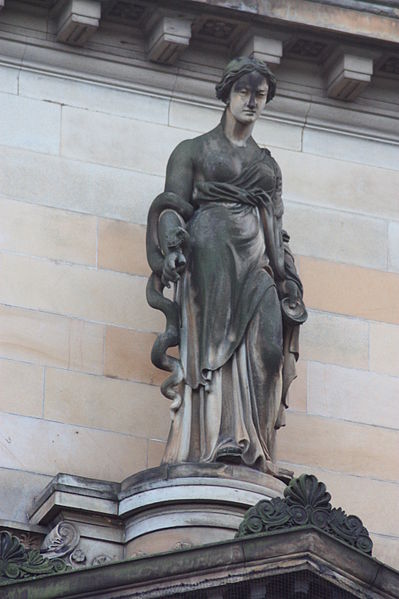Hygieia is a goddess from Greek mythology. Hygieia is a goddess of health, cleanliness and hygiene. Her name is the source for the word "hygiene".
1st-century Roman statue of the goddess
Image of a marble statue depicting the lower portion of the goddess Hygieia while seated with a portion of a snake coiled atop the legs. Located in the Roman collection in The Metropolitan Museum of Art, inv: 03.12.11a Dates to the 1st or 2nd century, A.D.
Statue of Hygieia in Art Deco style in Kraków, Poland (1932)
Hygieia by Alexander Handyside Ritchie, College of Physicians, Queen Street, Edinburgh
Asclepius is a hero and god of medicine in ancient Greek religion and mythology. He is the son of Apollo and Coronis, or Arsinoe, or of Apollo alone. Asclepius represents the healing aspect of the medical arts; his daughters, the "Asclepiades", are: Hygieia, Iaso, Aceso, Aegle and Panacea. He has several sons as well. He was associated with the Roman/Etruscan god Vediovis and the Egyptian Imhotep. He shared with Apollo the epithet Paean. The rod of Asclepius, a snake-entwined staff, remains a symbol of medicine today. Those physicians and attendants who served this god were known as the Therapeutae of Asclepius.
Asclepius with his serpent-entwined staff, Archaeological Museum of Epidaurus
Roman coin from Odessos showing Asclepius with Hygieia on one side and Gordian III's portrait on the other side (35mm, 28g)
Asclepius (center) arrives in Kos and is greeted by Hippocrates (left) and a citizen (right), mosaic, 2nd–3rd century AD
Votive relief of Asclepius, Epione and Hygieia. Mid-4th cent. BC, Acropolis Museum, Athens.








